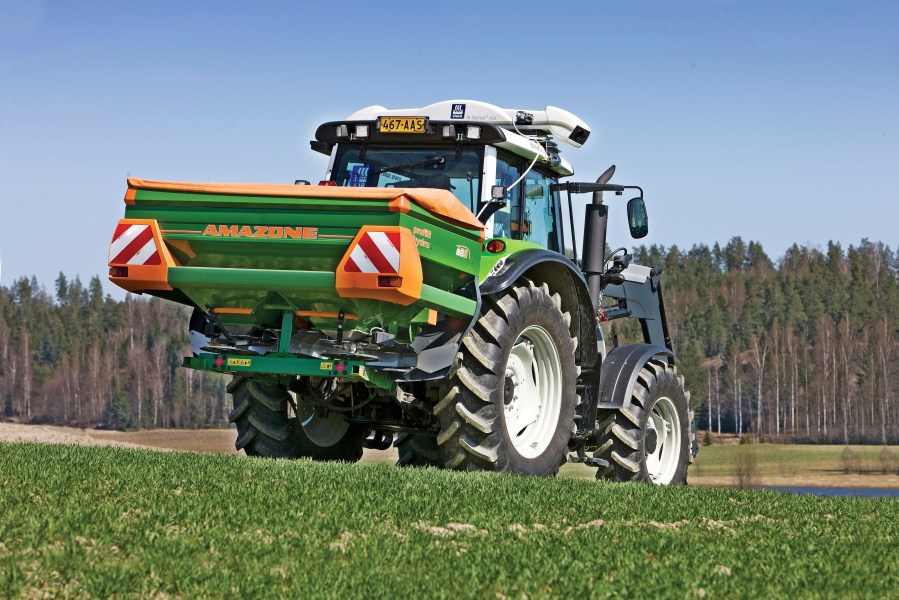Late-drilling needn’t mean a huge yield penalty. CPM finds out how tailoring nutrition can help boost the biomass that turns into yield.
In early spring (Feb-Mar), there’s a final opportunity to influence and recover crop biomass.
By Lucy de la Pasture
Delayed drilling has become established as one of the most influential cultural control methods to combat blackgrass. Keeping the seed in the bag until mid-Oct means there’s more opportunity to make the most of stale seedbeds, reducing the impact of blackgrass on the crop. There’s also the added bonus that the much-relied upon pre-emergence herbicides tend to work better in the slightly cooler, moister soils of late autumn.
But there’s a down-side to later-drilling, yields are generally lower and more variable. Yara’s Mark Tucker explains that by tailoring nutrition in early spring, there’s a golden opportunity to claw back lost yield potential and it’s a chance that’s being widely missed by many growers.

Mark Tucker suggests increasing early nitrogen rates on backward crops to stimulate early growth in an attempt to recover biomass.
What is the impact of later drilling?
Approximately 1M ha in the UK is infested with blackgrass, and the vast majority of growers are managing this using sowing date, either delaying planting until mid-Oct or spring cropping.
According to work by AHDB published in 2017, on-average yields decline by 0.3% each day sowing is delayed after 1 Sept in a weed-free situation. The research went on to show that at blackgrass populations of 25 plants/m2 or above, later-drilling provides a net gain – the loss in yield from sowing later is less than any yield loss from the blackgrass, while also reducing the blackgrass population.
Typical sowing date for wheat is middle/end Sept, which is the optimum timing for maximising the biomass of the crop. The Yield Enhancement Network (YEN) results provide a reminder of the importance of achieving high biomass, which has been identified as one of the factors consistently influencing yield.
How does it hold back yield?
The trouble with delayed planting is that crops effectively lose 4-5 weeks of growing time and are planted into colder soil. This results in fewer shoot numbers, which can’t be fully compensated for by raising seed rate, although this is an important strategy to help combat reduced establishment.
Earlier-planted crops benefit from the warm, well-aerated soils in Sept, ideal for maximum nutrient availability. Soil temperatures tend to decrease by 2⁰C every month and soils become wetter (less air-gaps), so conditions for nutrient supply become less favourable every week drilling is delayed.
The lower number of shoots and reduced biomass produced by late-drilled crops doesn’t just equate to aerial growth, their root systems are also reduced. This means that as well as a lower uptake of nutrients, the roots have less ability to scavenge nutrients efficiently. These factors add up to a crop that is less resilient and more prone to stress.
Why is early biomass important?
The yield relationship in cereal crops revolves around the capture of resources – solar energy and water – and their conversion into grain. Plants use light to convert carbon dioxide to biomass through photosynthesis with a maximum efficiency of 1.4 t/TJ, so the higher the crop biomass, the greater the yield potential. Of this biomass, up to 50-60% can be grain (50-60% Harvest Index), with the remainder making up the stems and leaves that end up as straw.
In early spring (Feb-Mar), there’s a final opportunity to influence and recover crop biomass while the crop is still moving through its vegetative growth stages. Once plants switch into reproductive growth at GS31; the tiller, shoot and root numbers which make up its biomass are established.
How can nutrition help?
If a crop has low biomass/low tiller numbers in early spring, encouraging early rapid growth and tillering will increase crop biomass, and it’s here that there’s scope for managing late-drilled crops differently.
Standard nitrogen-application practice in spring is to apply 40-50kgN/ha, but for late-drilled crops this could be increased to 70kgN/ha to stimulate tiller production and growth.
Getting it on as soon as possible in early spring is best so that nitrogen is available to plants as soon as they begin growing actively. This generally occurs when soil temperatures reach 5-6⁰C and can be determined by looking at plant roots, which will have white tips indicative of new growth. Late Feb is often the best time to safely apply fresh nutrients, at a time when supply of soil nutrients is at its lowest. This early nitrogen will help drive early growth, recover biomass (hence yield potential) and make the crop more resilient.
Why is spring-applied P important?
Phosphate fertiliser applied in the autumn has very limited uptake and mostly becomes ‘fixed’ over the winter, making it unavailable to plants – with trials showing up to 40% of autumn-applied phosphate is fixed within two weeks of application.
The implication of this is that phosphate isn’t available in an available form in early spring, when crops begin to grow away. The ‘fixing’ process isn’t reversed until the soil temperature has risen sufficiently for microbial activity to unfix phosphate back into the pool of available nutrients. For this reason, a spring application of at least 35Kg P2O5/ha can plug the gap in phosphate availability and boost root growth.
Availability of phosphate after application

Source: Yara, Hanninghof Research.
What approach works best?
Use AHDB Benchmarks to assess crop growth in the spring and move to a high N-rate of 70kgN/ha where biomass needs boosting for the first application. Follow as normal with a second dressing four weeks later comprising 50% of the total nitrogen dose. The final application of N will be the remainder of the total overall dose.
To further aid rapid spring growth and development, foliar applied nutrients can also be a useful input, especially foliar phosphate. This gives an immediate efficient supply of phosphate, activating energy in the plant, kicking off growth of roots to start extracting the soil applied nutrients. Apply a minimum of 35kg P2O5/ha as a fresh dressing in the spring.
AHDB Benchmarks

Source: AHDB Wheat Growth Guide
Effect of Nitrogen rate and timing on tiller density in winter wheat

Using 70 rather than 40 kgN/ha gave an extra 18% tillers. Source: Yara, 2014
What about variability?
It can be more difficult to get good crop establishment where crops are late-drilled and where there’s a lot of spatial variability within soils, this can result in considerable variation in plant populations in different parts of the field. For example, establishment may have been lower in any patches of heavy clay where the soil is colder and wetter.
Variable rate technology can be used to good effect to address this imbalance. Early nitrogen rates can be pushed up to 100kgN/ha where shoot numbers are lowest, to boost tillering and encourage early growth. Average areas should receive a standard application of 70kgN/ha, reducing to 40-50kgN/ha over any strong patches. Don’t risk lodging in these more fertile areas where plants are already doing well.
Change in approach boosts backward crops
Tom Hawthorne of Flawborough Farms in the Vale of Belvoir, has 2100ha of arable crops under his wing. It’s ‘man’s ground’, a notoriously heavy clay soil-type but one that’s capable of producing high-yielding crops.
Every decision made on the farm is based around managing its blackgrass problem, explains Tom. “In 2012 we hit the wall as far as blackgrass is concerned and changes had to be made to the way we farm. We lengthened our rotation to five years and introduced spring cropping, the idea being that any crop can be grown as a spring or autumn crop depending on the blackgrass pressure.”
Typically, the Flawborough rotation is winter wheat, followed in year two by winter wheat, winter barley or spring barley, then oilseed rape leading in to winter wheat and finally spring or winter beans.
Where some may have baulked at the idea of delayed drilling on heavy clay soils, Tom has resolutely stuck to his plan that autumn drilling doesn’t begin until 20 Oct. “The later, the better for blackgrass control. It’s just a change in mindset but you have to set yourself up to be able to do it,” he says.
Flawborough hasn’t been ploughed since the 1960s, though was fairly max-till until 2012. At that time Tom introduced Controlled Traffic Farming (CTF) and he now describes his cultivation strategies as ‘appropriate.’
“CTF has allowed us to cultivate for the crop rather than for repair of the soil. OSR is usually direct drilled but we shallow cultivate at 5-7.5cm for our autumn crops and a little deeper, 10-12.5cm, ahead of spring crops.”
About 40% of Tom’s ground receives either chicken manure or sewage sludge each year, generally after OSR. “Our soils are K-releasing clays but tend to be low in phosphate. The manure underneath the crop provides a useful background source of available P and K,” he believes.
He also applies an intense band of liquid fertiliser in autumn just below the depth of the seed to provide available nutrients in the rooting zone, helping get the crop up and away.
In the spring his late-drilled crops are backwards. They’re not thin but tiller numbers are down and often they weren’t planted in the best conditions, he says. Tom’s strategy diverges from conventional approaches at the first nitrogen timing to counter this, applying an increased first dose of N of up to 125kgN/ha, where necessary. He also applies fresh P and K.
“The aim is to help get crops going early in the spring, recover biomass and help suppress blackgrass,” he adds.
“We use the N-sensor and take biomass readings at every pass through the field and combine this information with satellite imagery and N-tester, which measures the nitrogen status of plants in the field. We also fly a drone and use Drone Deploy software to generate a NDVI picture of crops,” he says.
“In last year’s dry spring conditions, we really noticed that where crops had received a big dose of liquid N early, they looked much better under the drought stress.”
Nutrition for late-drilled crops: top tips
- Observe and measure crops – benchmark crops in mid-Feb to assess whether they are forwards or backwards, using the AHDB Wheat Growth Guide..
- Think and do things differently – prioritise fields that are backwards, applying higher rates of N.
- Consider other inputs – use PGRs strategically as an aid to tiller retention and survival




